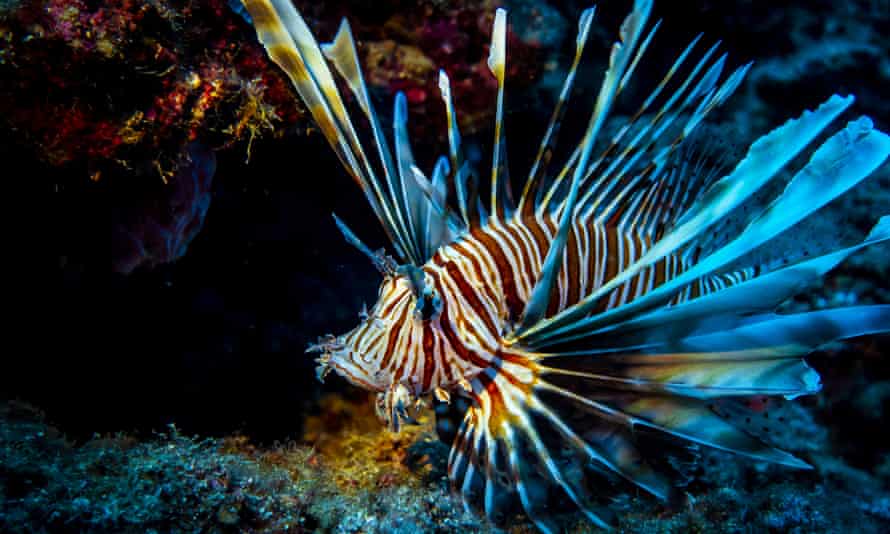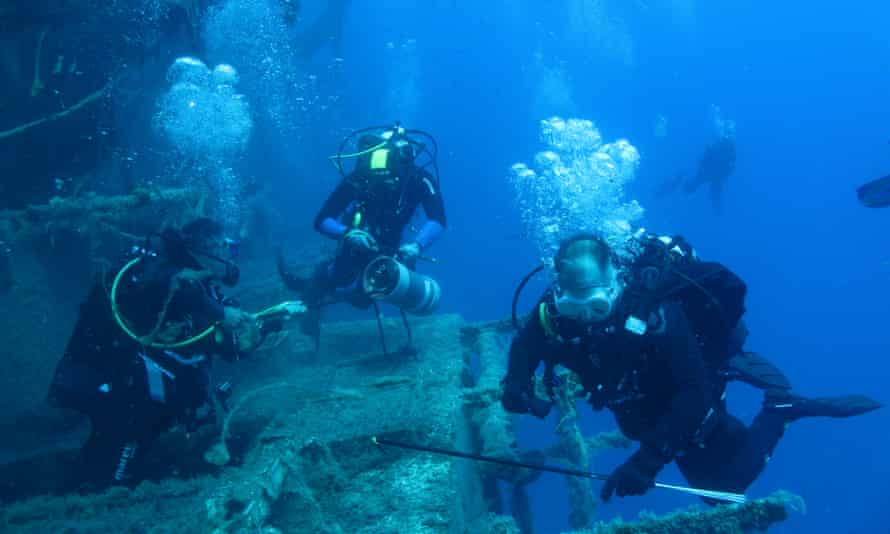‘I’ve seen 40 on one dive’: invasive lionfish threatens ecosystems in Med
A removal project aims to reduce numbers of the unwelcome arrival that has quickly become prevalent

Non-native lionfish have become increasingly common in parts of the Mediterranean in recent years, threatening local ecosystems and posing a hazard to humans through their venomous spines.
Marine biologist Prof Jason Hall-Spencer first saw a lionfish off the coast of Cyprus in 2016. It was just an individual, but the species – which produce about 2 million eggs each year and lack natural predators in their new environment – have quickly become prevalent. “In some places, I’ve seen 40 on one dive,” said Hall-Spencer, from the University of Plymouth.
To tackle growing lionfish numbers, Hall-Spencer and fellow researchers from the University of Plymouth and the Marine and Environmental Research Lab in Cyprus have worked with specially trained divers and citizen scientists to coordinate removal events and surveys over six months. The collaboration is part of the EU-funded ReLionMed project.
“[Lionfish] are right up in shallow depths where you can be swimming – we see them in 1 or 2-metre depth – and they can give you a really nasty sting because their fins are packed with venom,” said Hall-Spencer.

While there are records of lionfish in shallow waters, they mainly stick to deeper waters and thus pose more of a public health risk to divers, said Periklis Kleitou, lead author of the study published in Aquatic Conservation. “As they expand [their range], we hope that they will not invade the coastal areas, where there are a lot of tourists.”
But lionfish are causing more problems than the threat of a painful sting. Invasions of the species in other parts of the world have shown the carnivorous fish can quickly colonise reefs and reduce biodiversity in the area, a problem for the ecology of the reef and local fishers.
Native to the warm, tropical waters of the Indo-Pacific, the first official sighting in Europe was in 2012, and off Cyprus in 2014. Warming oceans and expansion of the Suez canal have played a role in the invasion of lionfish from the Red Sea into the eastern Mediterranean. They are spreading quickly, and some have reached Tunisia and Italy.
Now, research shows the removal of the fish has the potential to help control its populations.
Hall-Spencer said lionfish were being sighted within marine protected areas (MPAs), set up to safeguard native organisms in the Mediterranean. “What [MPAs] are effectively doing is they are protecting these invasive species – they provide havens – and that’s a worry,” he said.
“Eradication is out of the question,” said Dr Louis Hadjioannou, a research biologist jointly affiliated with the Cyprus Marine and Maritime Institute and Enalia Physis research centre. “We’re talking about controlling populations,” he said.
The team conducted five removals with specially trained volunteer divers who captured between 35 and 119 lionfish a day at each of the three studied marine protected sites off the coast of Cyprus.
The research also used citizen science to monitor lionfish numbers at the survey sites after the removals. A combination of the citizen science reports and fixed transect monitoring revealed lionfish abundance decreased after removals.
Recolonisation by lionfish occurred at different rates, which the researchers attributed to connectivity with neighbouring reefs. One problem is that lionfish can be found at up to 100 metres below the surface, a depth far exceeding recreational diving limits.
“That means that there is a reservoir of lionfish in areas unreachable,” Hadjioannou said. Those fish can come up to the area that has just undergone a removal and repopulate.
Monitoring of lionfish in the study occurred over a short time period. There is a need for longer-term studies to determine if removals can be a long-term solution, allow better timing of the events and help identify which locations to target for the best results.
Researchers identify a need for a multifaceted approach, including advocating for stronger protection of large predatory fish that may feed on lionfish and encouraging local fishers to catch them.
Indeed, visitors to Cyprus may soon see lionfish on the menu. It is already being seen on fish markets and in a few restaurants. As the market grows, it is hoped their value will increase. The project is also cooperating with markets to promote the sale of jewellery made from lionfish fins.
“With climate change, it is expected that lionfish will invade parts of the western Mediterranean,” said Kleitou, and with the fish already rife in other parts of the south-eastern Mediterranean, “the long-term goal is to continue to transfer our knowledge to their neighbouring countries”.
We also need to work to prevent further invasions, explained Hall-Spencer. He described the Suez as a “cut artery” that is “bleeding all these fish and other species, including viruses and bacteria, into the Mediterranean”.
“What really needs to happen is some sort of biosecurity control,” he added, and suggested using desalination plants that produce highly salty wastewater and put that in the Suez canal. “I think it’s going to require international coordination and probably international funding in order to get this biosecurity in place,” he said.